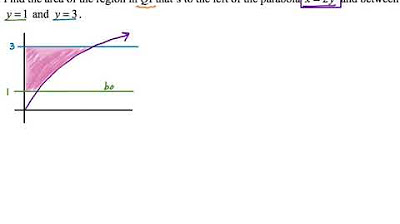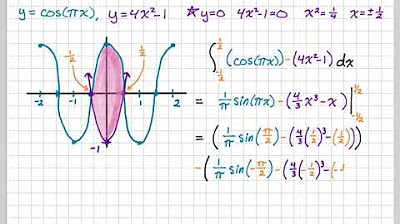Area Between Curves: Integrating with Respect to y (Example 3)
TLDRIn this video, the presenter demonstrates how to calculate the area between curves using calculus, specifically by integrating with respect to Y. The problem involves finding the area bounded by the curve y = √x, the horizontal line y = 1, and the vertical line x = 4. The presenter explains the need to identify four bounds (top, bottom, left, and right) to set up the integral, and since only three are given, the fourth must be determined. The left bound is transformed from y = √x to x = y^2 to facilitate integration. The integral is then set up from y = 1 to y = 2, subtracting the left curve (y^2) from the constant right curve (x = 4). The antiderivative is found, and the integral is evaluated from 1 to 2, resulting in the area of the region being 5/3. The presenter encourages practicing integration with respect to Y as well as X and emphasizes the importance of checking answers with a calculator.
Takeaways
- 📐 The video demonstrates how to use calculus to find the area between curves by integrating with respect to Y (dy).
- 🔍 The problem involves finding the area bounded by the curve y = √x, the line x = 1, and x = 4.
- 📏 To solve the problem, one must identify the lower (bottom), upper (top), left, and right bounds of the region.
- 🔑 Given three bounds, the fourth (left bound) needs to be determined by solving y = √x for x, resulting in x = y^2.
- 🖋️ The region is sketched by plotting the points where the curve intersects the given lines and filling in the bounded area.
- ➡️ The right curve is a constant x = 4, making it straightforward to work with when integrating with respect to Y.
- 🔄 The left curve y = √x is transformed into x = y^2 to integrate with respect to Y.
- 🧮 The integral to be solved is from y = 1 to y = 2, calculating the area under the right curve (x = 4) minus the left curve (x = y^2).
- 📐 The antiderivative of the integral is found by integrating 4y - y^2 with respect to y.
- ✅ The final answer is obtained by evaluating the antiderivative at the bounds y = 2 and y = 1, and then subtracting the results.
- 🤔 The video suggests that while the problem could be solved with respect to X, practicing with respect to Y is beneficial for a well-rounded understanding.
- 📊 It is recommended to use a calculator to check the answer and to simplify expressions by combining terms with the same denominator before proceeding with calculations.
Q & A
Why is it necessary to integrate with respect to y in the given problem?
-Integrating with respect to y is chosen to practice this method, as it is less commonly used compared to integrating with respect to x, and can provide a different perspective on solving area problems between curves.
What curves define the boundaries of the region in the problem?
-The region is bounded by the curve y = sqrt(x), the horizontal line y = 1, and the vertical line x = 4.
Why do you need four bounds to solve an area problem with integration?
-Four bounds are needed to clearly define the enclosed area for integration, typically consisting of lower, upper, left, and right boundaries to establish the limits of integration.
How is the curve x = 4 relevant in the context of integrating with respect to y?
-The curve x = 4 serves as a constant right boundary when integrating with respect to y, simplifying the calculation as it remains fixed across the integration interval.
What transformation is applied to the equation y = sqrt(x) for integration with respect to y?
-The equation is transformed to x = y^2 by squaring both sides to express x as a function of y, which is necessary for integration with respect to y.
How do you determine the limits of integration for y in this problem?
-The limits of integration for y are determined from the intersection points of the curves, with y = 1 as the lower limit and y = 2 as the upper limit, corresponding to the points where the curves intersect.
What is the significance of setting up the integral as 4 - y^2 in this problem?
-The expression 4 - y^2 represents the difference between the right and left bounds (x-values) at any given y, which directly calculates the width of the area slice for the integral.
How is the definite integral evaluated in this problem?
-The integral is evaluated by finding the antiderivatives of 4 and y^2, substituting the upper and lower limits of y, and calculating the difference to find the area.
Why is it recommended to combine like terms when simplifying expressions involving fractions?
-Combining like terms when dealing with fractions simplifies the calculation, reduces the risk of errors, and speeds up the process of finding the solution.
Could this area problem also be solved by integrating with respect to x, and why might one choose not to do so?
-Yes, the area problem could also be solved by integrating with respect to x, which might be simpler in some cases. However, practicing integration with respect to y provides valuable experience with different integration approaches and checks consistency of results.
Outlines
📐 Calculating Area with Calculus: √x and Bounds
The video introduces the use of calculus to determine the area between curves, specifically focusing on integrating with respect to Y. The problem involves finding the area bounded by the curve y = √x, the horizontal line y = 1, and the vertical line x = 4. The presenter explains that to calculate the area, one needs to identify the bounds of the region, which include a lower (bottom), upper (top), left, and right boundary. With three given, the video demonstrates how to find the missing left boundary by solving y = √x for x, resulting in x = y^2. The integral to be solved is then set up from y = 1 to y = 2, with the integrand being the difference between the right (constant x = 4) and left curves (x = y^2). The antiderivative is found, and the integral is evaluated from the bounds to find the area, which is simplified and checked for accuracy.
Mindmap
Keywords
💡Calculus
💡Integration
💡Curves
💡Bounds
💡Square root of x
💡Horizontal and Vertical Lines
💡Antiderivatives
💡Fundamental Theorem
💡Area of the region
💡Practice
💡Calculator
Highlights
The video demonstrates how to use calculus to find the area between curves by integrating with respect to Y.
The problem involves finding the area bounded by y = √x, x = 1, and x = 4.
To solve the problem, one must identify a lower bound (bottom), an upper bound (top), a left, and a right bound.
The region to be found is sketched using the given curves and lines.
The right-hand curve is a constant x = 4, which is common when integrating with respect to X.
The left-hand curve y = √x needs to be converted to x as a function of Y for integration purposes.
The integral setup is from y = 1 (bottom) to y = 2 (top), with the right curve minus the left curve.
The integral to be solved is ∫(4 - y^2) dy from y = 1 to y = 2.
The antiderivative of the integral is found using the fundamental theorem of calculus.
Substitution is performed for the upper limit (y = 2) and the lower limit (y = 1).
Combining terms with the same denominator simplifies the final expression.
The final area of the region is calculated to be 5/3.
The video emphasizes the importance of practicing integration with respect to both X and Y.
Using a calculator can help verify the answer for additional practice.
The video concludes by wishing viewers good luck and hoping the information was helpful.
Transcripts
Browse More Related Video

Area Between Curves: Integrating with Respect to y (Example 2)

Area Between Curves: Integrating with Respect to y (Example 1)

Finding a Horizontal Line (y=k) to Divide a Region into Two Equal Parts Using Calculus

Area Between Curves: y = cos(pi*x), y = 4x^2 -1

Disc method rotating around vertical line | AP Calculus AB | Khan Academy

Disc method around y-axis | Applications of definite integrals | AP Calculus AB | Khan Academy
5.0 / 5 (0 votes)
Thanks for rating: